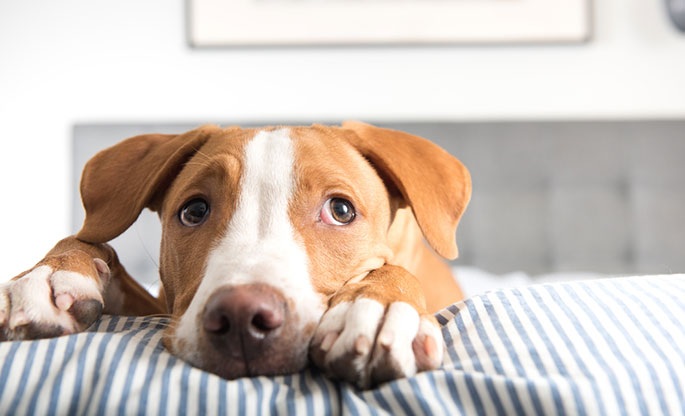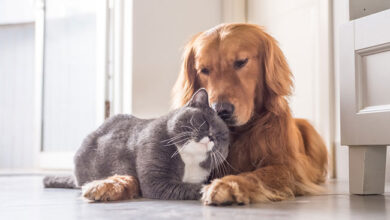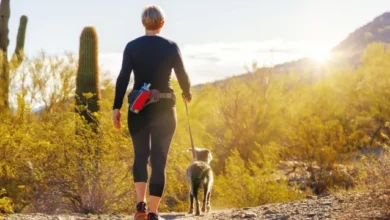
Dogs are naturally curious creatures. Fearless and ready for adventure, our pups experience the world with heightened senses of sound, smell, and taste. So it’s not unusual to catch your pooch counter-surfing for chicken wings or trying to leap out of the car window (to chase the traffic whizzing by).
Back on the home front, our dogs are often lured to the citrus scents of toxic household chemicals and can easily follow their natural instincts into hazardous situations. So how can you tell when your dog actually does hurt herself? What are the symptoms? And is it serious enough for a visit to the veterinarian?
Symptoms of Sickness
You should get in the habit of checking your dog on a daily basis. Lift her ears and look for ticks, part her hair until you can see the skin and search for fleas. How’s her skin looking? Is it dry? Lift her lips and have a close look at the teeth and gums. Do you see any inflammation or bleeding?
These 5 physical symptoms, in particular, are red flags that require immediate medical attention:
- Continuous nasal discharge – Indicates the possible presence of a virus or bacteria. By the way, your dog can get a cold, the flu, and even pneumonia.
- Vomiting – once or twice isn’t bad—in fact it may be desired if food is indigestible. But if it occurs more than that, talk to your vet immediately. This could be a symptom of a greater illness.
- Constant scratching – If your dog just sits on the floor and scratches herself nonstop, then begin with a close examination of her skin. Separate the hair and look at the skin. Do you notice dandruff, lice (looks like blotches of dirt), or fleas on skin? What about redness or swelling? Skin issues are prevalent in dogs and maybe address with a {healthier diet}, topical treatment, or medication.
- Irregular stool – As with vomiting, one or two loose bowel movements is not a cause for major concern. But if your pup continues passing loose stool over a period of days, then she may have an infection or other bowel disorder. On the other end of the scale, constipation over a period of two to three days also causes for concern. A good vet will help you get to the root of these digestive problems and to prescribe treatment.
- Limping – Observe your dog’s walk. Is she favouring certain legs over others? If she’s hobbling a bit, then first check her feet. Gently squeeze her paw in your hand and watch for any reaction. If she quickly jerks away, then perhaps she’s injured her paw. Many older dogs are reluctant to walk around at all, so be sure to get your aged pooch plenty of exercises to ensure proper circulation and nerve activity.
The Role of Your Vet
First of all, make sure your dog receives an annual check-up with the veterinarian. Even though you can check her teeth, paws, and skin at home, a professional doctor can examine your beloved pup for many other problems that you’d likely overlook. On that same note, keep in mind that even a “minor” injury deserves a call to your veterinarian. Just check-in, explain what happened, and ask if it’s necessary to have your dog professionally examined. The goal here is to ensure that you don’t miss a more serious problem…Better safe than sorry.
Prevention is Key
The most common household dog injuries include: choking, electrical shock, chemical poisoning, puncture wounds, and fractures. However, with proper planning around the home, you can prevent many of these injuries before they ever happen.
Here are some simple tips:
- Electrical Hazards – Many dogs are drawn to electrical cords and some love nothing more than to chew on the plastic insulation which protects the high-voltage wires. Of course, once punctured, the live wires can cause severe burns inside your dogs’ mouth. As a result, make sure all cords are out of reach, better yet, out of sight. And if they are within striking distance, then cover the cords with duct tape or CritterCord protector so your pooch can’t gnaw at it.
- Food And Exercise – You knew this was coming…don’t give your dog table scraps! Leftovers are loaded with fat and sodium (which are not exactly healthy for humans either) and should not be given to the dog. The best diet for your pooch is either a homemade meal recommended by your vet or a premium highly digestible commercial dog food. Also, make sure the water fountain for your dog is always freshly filled. Oh, and please take your dog out for exercise. Depending on the breed, this may be as simple as a 15-minute walk each day. And let’s face it, we owners need to get outside and walk around the neighbour more anyway…right? Talk to the vet if you’re unsure of how much exercise your pup needs.
- Toxic Chemicals And Poisons – Keep your dog away from bleaches, detergents, cleaners, polishers, and all other household chemicals. Surprisingly, houseplants should also be out of reach. Most people don’t realize that many varieties of common plants are toxic and can make your dog severely ill, in some cases even leading to death. And here’s a no-brainer: Keep all medicines secured and out of reach.
- Travelling In The Car – If your dog is a leaper—you know, the type that would soar out of an open car window at the sight of a postal worker—then invest in a high-quality travel carrier, kennel, or car seat. Be careful when allowing your dog to stick her head out of the window, and never allow your dog to ride in the bed of a pickup truck.
- Trash – Keep the garbage tightly closed both inside and outside your house. If possible, keep the kitchen trash behind a closed door or secured in a cabinet under the sink.
The Banned-Foods List
While we’re discussing the kitchen, here’s a quick list of foods that you should never feed your dog:
- Caffeine, which is found in coffee, tea, and chocolate
- Dairy products such as milk and cheese
- Raisins and grapes
- Human vitamin s &supplements which contain iron or liver
- Mushrooms, onions, garlic, and potatoes



